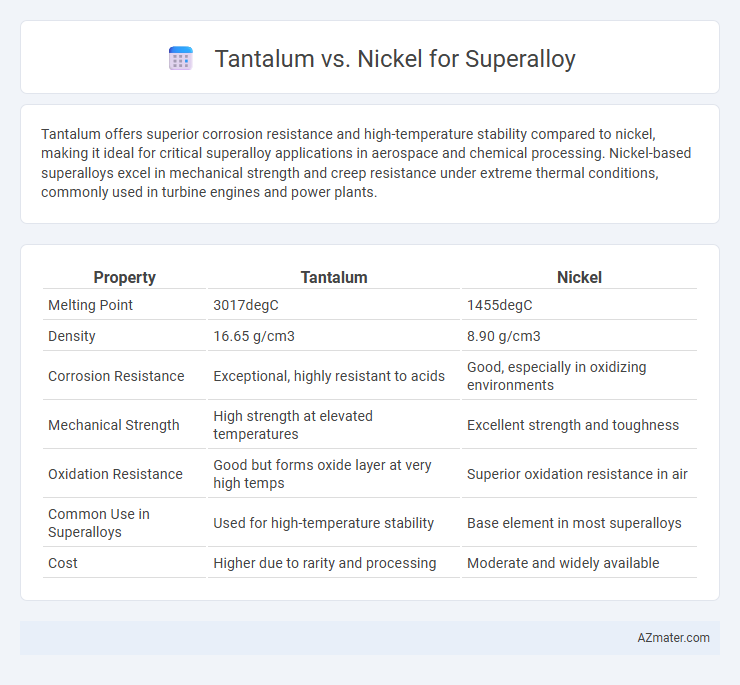Tantalum offers superior corrosion resistance and high-temperature stability compared to nickel, making it ideal for critical superalloy applications in aerospace and chemical processing. Nickel-based superalloys excel in mechanical strength and creep resistance under extreme thermal conditions, commonly used in turbine engines and power plants.
Table of Comparison
| Property | Tantalum | Nickel |
|---|---|---|
| Melting Point | 3017degC | 1455degC |
| Density | 16.65 g/cm3 | 8.90 g/cm3 |
| Corrosion Resistance | Exceptional, highly resistant to acids | Good, especially in oxidizing environments |
| Mechanical Strength | High strength at elevated temperatures | Excellent strength and toughness |
| Oxidation Resistance | Good but forms oxide layer at very high temps | Superior oxidation resistance in air |
| Common Use in Superalloys | Used for high-temperature stability | Base element in most superalloys |
| Cost | Higher due to rarity and processing | Moderate and widely available |
Introduction to Superalloys: Importance and Applications
Superalloys, known for exceptional mechanical strength and resistance to thermal creep deformation, commonly incorporate elements like tantalum and nickel to enhance performance. Nickel-based superalloys dominate aerospace and power generation industries due to superior oxidation resistance and high-temperature strength, while tantalum additions improve corrosion resistance and grain structure stability. These properties enable superalloys to maintain integrity in extreme environments such as jet engines and gas turbines, driving advancements in high-performance materials.
Chemical Properties: Tantalum vs Nickel
Tantalum exhibits exceptional corrosion resistance and high melting point of approximately 3017degC, making it ideal for superalloy applications exposed to extreme environments. Nickel, with a melting point of 1455degC and excellent strength at high temperatures, contributes to superalloys' oxidation resistance and mechanical durability. The chemical stability of tantalum against acids and its low reactivity contrast with nickel's versatility in forming stable alloys, enhancing superalloy performance in aerospace and industrial turbines.
Mechanical Strength Comparison
Tantalum offers superior high-temperature mechanical strength compared to nickel, making it essential for enhancing creep resistance in superalloys used in aerospace and turbine applications. Nickel-based superalloys exhibit excellent overall mechanical strength and oxidation resistance but tend to have lower melting points and reduced strength retention at extreme temperatures relative to tantalum-enhanced alloys. The incorporation of tantalum significantly improves yield strength and tensile strength, especially in environments exceeding 900degC, where nickel-based superalloys alone may experience performance degradation.
Corrosion and Oxidation Resistance
Tantalum exhibits superior corrosion resistance compared to nickel in superalloys, particularly in aggressive environments containing acids and chlorides, due to its stable oxide layer formation. Nickel-based superalloys provide excellent oxidation resistance at high temperatures, driven by the formation of a protective nickel oxide scale that enhances durability in oxidative atmospheres. Combining tantalum with nickel in superalloys can optimize both corrosion and oxidation resistance, improving performance in extreme environments such as aerospace and chemical processing.
High-Temperature Performance
Tantalum exhibits superior high-temperature stability and oxidation resistance compared to nickel, making it ideal for superalloys used in extreme environments such as aerospace turbines. Nickel-based superalloys maintain excellent mechanical strength and creep resistance at elevated temperatures, yet tantalum's ability to form stable oxide layers enhances longevity and performance under prolonged thermal stress. The combination of tantalum's refractory properties with nickel's ductility often leads to optimized superalloys for components requiring both toughness and thermal endurance.
Weight and Density Differences
Tantalum exhibits a density of approximately 16.69 g/cm3, significantly higher than nickel's density of around 8.90 g/cm3, making tantalum considerably heavier for equivalent volumes in superalloy applications. This density disparity influences the overall weight of superalloy components, with nickel-based superalloys preferred where lower weight and improved strength-to-weight ratios are critical, such as in aerospace engines. The choice between tantalum and nickel hinges on balancing weight constraints against specialized high-temperature performance and corrosion resistance requirements.
Cost and Availability
Tantalum offers superior corrosion resistance and high melting points, making it valuable in high-performance superalloys, but its cost is significantly higher due to limited global supply and complex extraction processes. Nickel remains the dominant base metal in superalloys because of its abundant availability, lower cost, and excellent mechanical properties at elevated temperatures. The choice between tantalum and nickel hinges on balancing cost-efficiency with specific performance requirements in aerospace and industrial applications.
Applications in Aerospace and Power Generation
Tantalum alloys offer superior corrosion resistance and high melting points, making them ideal for aerospace turbine blades and jet engine components exposed to extreme temperatures. Nickel-based superalloys dominate power generation applications due to their exceptional mechanical strength, creep resistance, and oxidation stability in gas turbines and nuclear reactors. The choice between tantalum and nickel superalloys depends on specific performance requirements including temperature thresholds and environmental conditions in aerospace and power generation sectors.
Environmental and Sustainability Considerations
Tantalum offers superior corrosion resistance and recyclability compared to nickel, making it a more sustainable choice for superalloys in environmentally sensitive applications. Nickel production involves significant energy consumption and greenhouse gas emissions, whereas tantalum can be sourced with lower environmental impact through responsible mining practices and enhanced recycling programs. The long lifespan and recyclability of tantalum-based superalloys reduce material waste and support circular economy principles in high-performance industries.
Final Verdict: Selecting the Ideal Superalloy Component
Tantalum provides superior corrosion resistance and high-temperature stability, making it ideal for extreme environments in superalloy applications. Nickel-based superalloys excel in mechanical strength and creep resistance under prolonged high temperatures, enabling durability in turbine engines and aerospace components. Selecting the ideal superalloy component depends on balancing the operational conditions, with tantalum favored for chemical resilience and nickel for structural integrity.

Infographic: Tantalum vs Nickel for Superalloy
 azmater.com
azmater.com